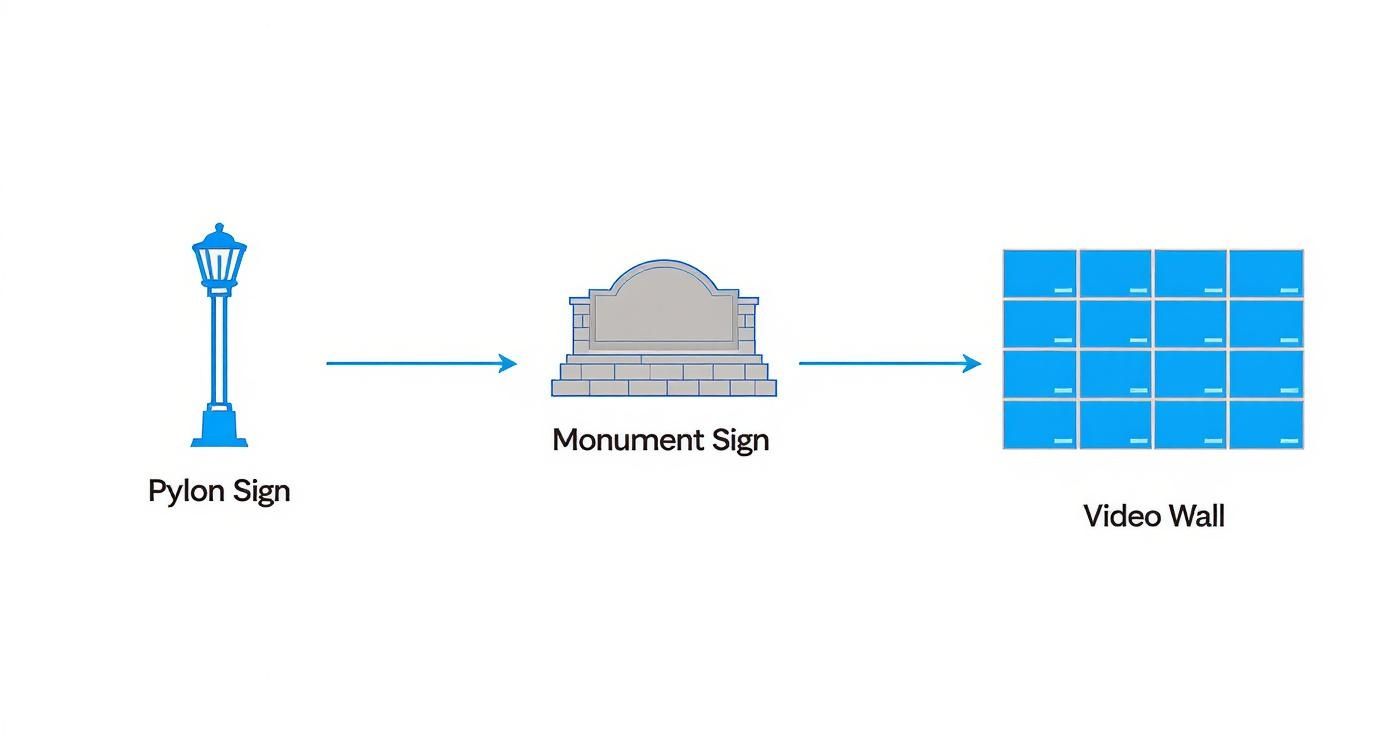
Ultimate Roll Up LED Display Guide
A roll up LED display feels like a high-resolution screen you can stash in a poster tube. In a few seconds, it unfurls into a

LED signs are more than just bright lights; they’re powerful marketing tools that turn your storefront into a dynamic, attention-grabbing beacon. Unlike the static, outdated signs of the past, these displays let you change promotions, update messaging, and refresh your branding in real-time, making them an essential investment for any modern business.

Picture your storefront on a busy street, surrounded by a sea of visual noise. A traditional painted sign or a simple vinyl banner just blends in. But a vibrant LED sign? It cuts through the clutter, actively pulling eyes—and potential customers—right to your door. This isn’t just about being seen; it’s about starting a conversation.
For years, businesses were stuck with static signs. Announcing a sale meant printing a new banner. Promoting a seasonal special required yet another temporary sign. This old-school approach is slow, costly, and simply can’t keep up in today’s fast-moving market.
Dynamic LED signs for businesses completely change the game. They transform your storefront into a live, adaptable marketing platform, empowering you to communicate with customers at the most critical moment—when they’re right outside.
Think of your LED sign as your 24/7 salesperson. It can shout about a flash sale in the afternoon, promote a happy hour special in the evening, and share a heartfelt community message overnight. This kind of agility is something static signs could only dream of. The benefits are direct and easy to see:
A well-placed and thoughtfully managed LED sign does more than just advertise; it becomes a landmark. It tells the community you are active, modern, and ready to engage. This shift from passive signage to active communication is a fundamental advantage.
The switch to digital displays isn’t just a fleeting trend; it’s a massive market shift. The global digital signage market is on track to hit an incredible $45.94 billion by 2030, with retail businesses making up a huge 25% of that. This growth isn’t surprising—it’s a clear sign that business owners are seeing the undeniable ROI of dynamic visuals.
Investing in powerful digital outdoor signage is a strategic move to future-proof your business’s visibility and marketing muscle. It’s an investment in flexibility, engagement, and ultimately, your bottom line.
Picking the right LED sign for your business isn’t a one-size-fits-all deal. It’s like choosing the right tool for a job—a sledgehammer is great for demolition, but you wouldn’t use it to hang a picture. The sign you choose depends entirely on where you’ll put it and what you want it to accomplish.
The first big question is: indoor or outdoor? While they’re both built on LED technology, they are engineered for completely different worlds. An outdoor sign has to be a beast, ready to take on everything from a blizzard to a blazing summer sun. An indoor sign, on the other hand, is all about creating an up-close, high-impact experience for people already inside your space.
Figuring out where your sign will live and what you need it to do is the first step. Let’s break down the most common types of LED signs for businesses to see which one makes sense for you.
Think of your outdoor sign as a modern-day lighthouse. Its job is to cut through the noise of a busy street and guide customers right to your front door. To do that, it needs to be bright, tough, and readable at a glance.
There are a few key players in the outdoor sign game:
Here’s a simple way to think about it: a pylon sign shouts your name across town, a monument sign offers a firm, welcoming handshake at your driveway, and a storefront sign starts a direct conversation with someone on the sidewalk.
Once you’ve guided customers through the door, your indoor LED signs take over. Their mission changes from grabbing attention to creating a memorable, immersive brand experience. Because people view them up close, they pack a much higher resolution for stunningly crisp, detailed visuals.
Indoor signs can completely transform a space. A small, bright LED sign in a cafe window can advertise the daily special, catching the eye of pedestrians and turning a passive glance into an impulse buy. That simple sign just turned your window into a 24/7 salesperson.
On the other end of the spectrum, a large retailer or corporate lobby might install a massive video wall. This isn’t just a sign; it’s a digital canvas. You can use it to tell your brand’s story, showcase new products with cinematic flair, or create a unique ambiance that makes people want to stick around.
For a more detailed breakdown of the selection process, our guide on how to buy an LED sign is a great next step. It walks you through everything you need to know to make the right call.
Ultimately, it comes down to your goals. Are you trying to pull cars off a busy highway, or are you trying to create an unforgettable in-store experience? Answering that question will point you straight to the perfect LED solution for your business.
Jumping into a spec sheet for an LED sign can feel like trying to read a foreign language. You’ll see terms like “pixel pitch” and “nits” thrown around, but what do they actually mean for your business? Getting a handle on these core details is the secret to investing in a sign that not only looks incredible but performs exactly how you need it to.
Think about it: you wouldn’t buy a new delivery van without checking its mileage or cargo space. The same logic applies here. Understanding a few key specs ensures your money is well-spent on a sign that delivers real results, not just a bunch of confusing numbers. If you want to go deeper, a good Digital Sign LED explainer guide can be a huge help.
This concept map gives a quick overview of a few common types of LED business signs.

From towering pylon signs that grab attention from the highway to immersive video walls that create an in-store experience, each sign has unique technical needs to make the biggest impact.
The first term you’ll almost always run into is pixel pitch. In simple terms, this is the distance in millimeters (mm) from the center of one tiny LED light to the center of the one next to it. A smaller pixel pitch number just means those lights are packed closer together.
Imagine you’re creating a mosaic. If you use big, clunky tiles spaced far apart, your image will look blocky and crude up close. But if you use tiny, tightly packed tiles, you can create a stunning, high-definition picture. That’s a perfect analogy for how pixel pitch works on LED signs for businesses.
Picking the wrong pixel pitch is one of the most common—and costly—mistakes we see. Putting an indoor-rated pixel pitch on a highway billboard is a waste of money, while using a high pixel pitch for an indoor sign will just look pixelated and unprofessional.
Next up is brightness, which is measured in a unit called a “nit.” This one is absolutely non-negotiable for outdoor signs that have to go head-to-head with bright, direct sunlight. A sign that looks brilliant at dusk could be completely invisible on a sunny afternoon if its nit rating is too low.
It’s just like your smartphone screen. You have to crank the brightness to the max to see it clearly at the beach. An outdoor LED sign needs to do the same thing, just on a much, much bigger scale. You should be looking for a rating of at least 5,000 nits for any outdoor sign, with top-tier models hitting 8,000 nits or more to guarantee visibility in any weather.
Just as important for outdoor signs is the IP rating. The “IP” stands for Ingress Protection, and this two-digit number tells you exactly how well the sign’s casing protects the sensitive electronics inside from solids (like dust) and liquids (like rain).
An IP rating is like the waterproof rating on a diver’s watch. The first digit rates protection against solids (on a 0-6 scale), and the second rates protection against liquids (on a 0-9 scale). For any sign that will live outdoors, you need a rating of IP65 or higher to know it’s truly built to last.
This simple rating is your guarantee that the investment you’re making is protected from dust, downpours, and snow, ensuring it will keep working for you, no matter what the weather throws at it. Once you get these simple concepts down, you’re no longer a confused buyer—you’re an informed investor, ready to choose a sign that will genuinely work for your business.
A stunning LED sign loses all its power if it’s the wrong size for its location or hidden from view. A great sign in the wrong place is just a wasted opportunity. Nailing down the logistics of size, placement, and legal compliance before you even think about installation is the most critical step to ensure your investment pays off.
Think of your sign’s placement like real estate—location is everything. You need to identify the most valuable spot on your property to capture the most eyeballs. This means getting out there and analyzing traffic patterns, both on foot and in vehicles, to find the sightlines that matter most.
Proper planning transforms your sign from a simple display into a strategic marketing machine. Let’s walk through how to get these foundational elements right.
Choosing the right size isn’t just about what looks good; it’s a science based on how people will actually see it. A sign that’s too small will be unreadable from the road, while one that’s unnecessarily large can be an inefficient use of your budget. The goal is to find that sweet spot for maximum readability and impact.
Here’s a simple rule of thumb that can help you estimate the ideal character height:
So, if your primary audience is in cars about 300 feet away, your letters need to be at least 30 inches tall to be easily legible. This calculation is a fantastic starting point for figuring out the overall dimensions for your LED signs for businesses.
Once you have a general idea of the size, the next question is where it should go. The best location is rarely right above your front door. You need to think like a customer approaching your business for the first time.
Consider these key factors:
The most effective sign placement creates an “unavoidable” visual moment for your target audience. It should command attention without being disruptive, naturally drawing the eye as people move through their daily routines.
This is the step that trips up a lot of business owners. Every single city, county, and municipality has its own set of rules—zoning ordinances—that govern the size, height, brightness, and even the type of content allowed on business signs. Ignoring these regulations can lead to costly fines, forced removal, and serious project delays.
Before you even get a quote, start your research. Here’s a simple checklist to get you started:
Navigating this process can be a real headache, which is why partnering with an experienced sign company is so valuable. They’ve been through it all before, understand the local landscape, and can manage the permitting process for a smooth, compliant, and successful installation.
Now for the question every business owner lands on: what does an LED sign really cost, and is it worth the investment? It’s easy to get focused on the initial price tag, but looking at it as just another expense is missing the bigger picture. A well-chosen, well-placed LED sign is a revenue-generating asset, and you need to understand both the budget and the return to see its true value.
The cost of LED signs for businesses can swing wildly, and it all comes down to a few key things. Size is the most obvious factor, but specs like a tighter pixel pitch for a crisper, high-resolution image also play a huge part. And don’t forget installation—mounting a sign on a towering pylon is a completely different ballgame than putting one up on a simple storefront wall.
This is why you’ll never get a one-size-fits-all answer. The best first step is to get a solid handle on what drives the https://smartledinc.com/outdoor-led-sign-cost/. That’s how you build a realistic budget from the get-go.
When you start crunching the numbers, think of the sign as a long-term capital investment in your marketing. The final price is a blend of the hardware quality, the software that runs it, and the labor to get it all set up.
As you map out the financial side, understanding the nuances between equipment financing vs. leasing can be a game-changer for your budget. These options can make a big upfront investment feel much more manageable.
The real magic happens when you start seeing the direct impact your sign has on your bottom line. Unlike a static billboard, a dynamic LED sign lets you connect the dots between cause and effect. Run a specific promotion, and you can literally watch the lift in sales or foot traffic.
The goal is to shift the conversation from, “How much does it cost?” to, “How much revenue can it generate?” An LED sign isn’t just a purchase; it’s a tool that actively works to bring customers through your door.
Here’s a simple way to start measuring your sign’s success:
The good news is that these powerful tools are more accessible than they’ve ever been. The global LED display market is expected to hit $19.67 billion in 2025 and keep climbing to $25.98 billion by 2030. As hardware costs come down and the software gets smarter, high-impact digital advertising is no longer just for the big guys. By tracking the right metrics, you can clearly prove that your LED sign isn’t just paying for itself—it’s actively growing your business.

Your new LED sign is finally in place, but the work isn’t over—it’s just getting started. A professional installation sets the stage for flawless performance, but it’s consistent maintenance and fresh content that truly unlock your sign’s long-term value.
Think of it like a high-performance car. The build quality gets it off the lot, but it’s the regular upkeep and a skilled driver that win the race. This final phase ensures your investment keeps turning heads and driving business for years to come.
While it might be tempting to find a cheaper way, professional installation is a non-negotiable step for safety and longevity. Certified technicians don’t just hang a sign. They ensure it’s structurally sound, weatherproofed correctly, and compliant with all electrical codes.
This expert setup is your defense against water damage, power failures, and instability—all of which lead to costly repairs and dangerous situations down the road. It also optimizes performance from day one, with experts calibrating the display for your specific environment. This is the foundation for a decade or more of high-impact advertising.
An LED sign is a tough piece of tech, but it still needs basic care to maintain its brilliance. A simple, proactive maintenance routine can easily help you get the full lifespan out of it, which can be 100,000 hours or more.
Follow this straightforward checklist to keep your sign in peak condition:
Keeping your sign clean and updated is like changing the oil in your car. It’s a simple, low-cost habit that prevents major breakdowns and ensures you get the maximum value from your investment.
Your sign’s greatest strength is its ability to change. The intuitive software that powers modern LED signs is your command center for creating and scheduling messages that drive real customer action. This is where your marketing strategy truly comes to life.
To make your content pop, focus on designs built for at-a-glance viewing:
By combining a professional installation with routine maintenance and dynamic content, your LED sign becomes so much more than a bright display. It evolves into a reliable, powerful, and revenue-generating marketing asset that works for your business day in and day out.
Making a big investment in your business, like a new LED sign, naturally comes with a few questions. That’s a good thing! It means you’re thinking strategically. To help you feel confident in your decision, we’ve put together answers to some of the most common questions we hear from business owners.
This is the big one, right? The honest answer is: it varies. The price for LED signs for businesses can range from a few thousand dollars for a straightforward indoor display to well over $100,000 for a massive, high-resolution outdoor marquee.
Think of it less like buying a product off the shelf and more like a custom project. The final cost really boils down to a few key ingredients:
The best way to approach it is as a long-term investment in your marketing. Don’t forget, most reputable suppliers offer financing options to make the upfront cost much easier to handle.
Not in the slightest. If you’ve ever worried about needing a computer science degree to run a digital sign, you can relax. The days of clunky, confusing software are long gone.
Today’s signs are managed through incredibly user-friendly, cloud-based platforms. This means you can design your ads, upload new graphics, and schedule your messages from anywhere with an internet connection—your office computer, your laptop at home, or even your phone while you’re on the go. A little bit of basic training is usually all it takes to have you managing your sign like a seasoned pro.
A quality-built commercial LED sign is an absolute workhorse. You can typically expect a lifespan of around 100,000 hours of operation.
What does that look like in the real world? If your sign is running 12 hours a day, every day, that shakes out to roughly 10 to 12 years of dependable performance.
The lifespan of your sign is directly tied to a few things: the quality of the components inside, how well it’s built to handle your local weather, and whether you keep up with basic maintenance. Always ask about the warranty—a good manufacturer will stand behind their product with a warranty that’s typically between five and seven years.
Ready to see how a powerful LED sign can completely change how customers see your business? The team at Smart LED Inc. is here to help. We offer factory-direct pricing and nationwide support to walk you through everything, from initial design to final installation.

A roll up LED display feels like a high-resolution screen you can stash in a poster tube. In a few seconds, it unfurls into a

So, you're thinking about a video wall. The big question on everyone's mind is always: what's this actually going to cost? The honest answer is,

Think about the walls around you. For most of history, they’ve been static, passive surfaces. But what if a wall could come alive? What if
"*" indicates required fields